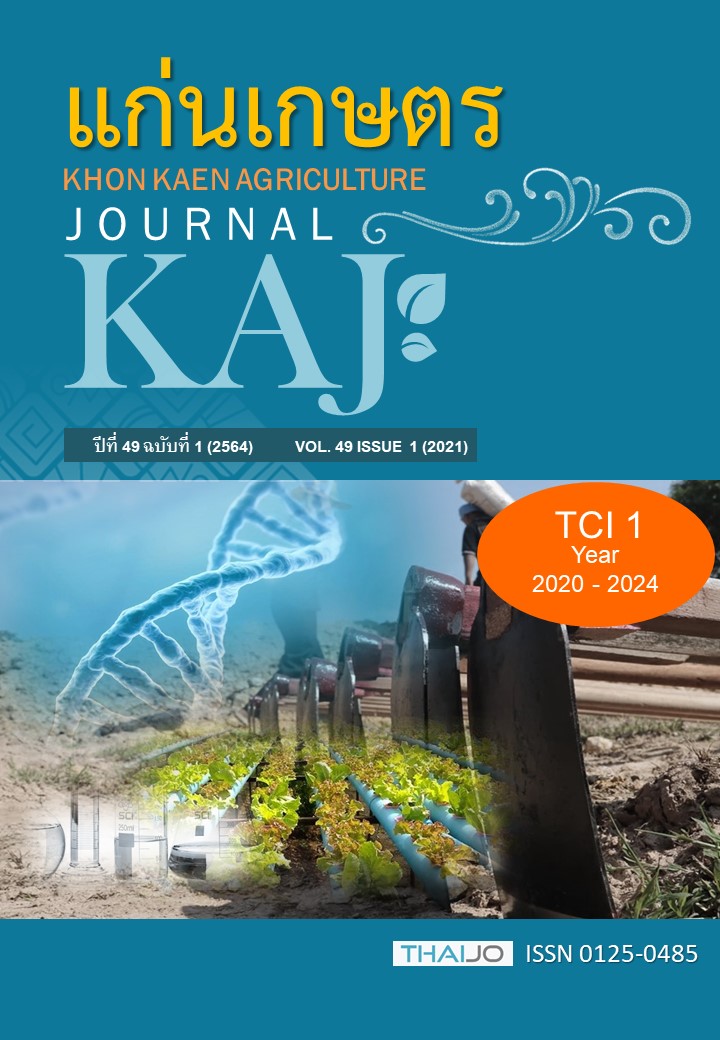ลายเซ็นเชิงคลื่นของข้าวที่มีต่อสภาวะเครียดจากก๊าซโอโซนด้วยเทคโนโลยี การรับรู้จากระยะไกลแบบไฮเปอร์สเปกตรัลภาคพื้นดิน
Main Article Content
บทคัดย่อ
การศึกษาครั้งนี้มีวัตถุประสงค์ เพื่อศึกษาลักษณะลายเซ็นเชิงคลื่นของข้าวเจ้าพันธุ์ กข43 ที่มีต่อ สภาวะความเครียดจากผลกระทบของก๊าซโอโซนที่ระดับความเข้มข้นต่ำกว่า 10 ppb (ชุดควบคุม) 40 ppb และ 80 ppb ด้วยเครื่องวัดค่าการสะท้อนแสงแบบไฮเปอร์สเปกตรัล (Spectroradiometer) ในแต่ละช่วงการเจริญเติบโต ผลการศึกษา พบว่า เครื่องวัดค่าการสะท้อนแสงแบบไฮเปอร์สเปกตรัล สามารถแยกข้าวที่ได้รับและไม่ได้รับก๊าซโอโซน ได้ในช่วงการเจริญเติบโตทางการสืบพันธุ์ (หลังรมก๊าซโอโซน 14 วัน) หากพิจารณาค่าการสะท้อนในแต่ละช่วงคลื่น พบว่า ช่วงคลื่นสีเขียว สีแดง อินฟราเรดใกล้ และอินฟราเรดคลื่นสั้น สามารถจำแนกความแตกต่างระหว่างชุดควบคุมกับชุดทดลอง ได้อย่างมีนัยสำคัญทางสถิติ (p<0.05) โดยในช่วงการเจริญเติบโตทางการสืบพันธุ์ มีค่าการสะท้อนที่แตกต่างกันอย่างชัดเจนในช่วงคลื่นอินฟราเรดใกล้ (740 - 1350 nm) ที่ระดับความเข้มข้นของก๊าซโอโซน 80 ppb มีค่าการสะท้อนแสงของคลื่นแม่เหล็กไฟฟ้าเฉลี่ยสูงที่สุดเท่ากับ 0.385±0.024 รองลงมา คือ ความเข้มข้นของก๊าซโอโซน 40 ppb (0.373±0.019) และ ชุดควบคุม (0.256±0.011) ผลที่ได้จากการศึกษาครั้งนี้จะสามารถใช้เป็นแนวทางในการติดตามและเฝ้าระวังผลกระทบจากก๊าซโอโซนต่อข้าว ด้วยเทคโนโลยีการรับรู้จากระยะไกลแบบไฮเปอร์สเปกตรัลภาคพื้นดิน
Article Details

อนุญาตภายใต้เงื่อนไข Creative Commons Attribution-NonCommercial-NoDerivatives 4.0 International License.
เอกสารอ้างอิง
จรัณธร บุญญานุภาพ. 2557. หลักการรับรู้จากระยะไกลด้านนิเวศวิทยาพืชพรรณและการอนุรักษ์. สำนักพิมพ์โอเดียนสโตร์. กรุงเทพฯ.
สถาบันวิจัยข้าว. 2548. การใช้แผ่นเทียบสี (Leaf Color Chart) เพื่อการจัดการปุ๋ยไนโตรเจนในการปลูกข้าวนาชลประทาน. แหล่งข้อมูล: http://www.brrd.in.th/rkb/content/manual/E-book/Eb_015.pdf. ค้นเมื่อ 23 มกราคม 2561.
Akhtar, N., M. Yamaguchi, H. Inada, D. Hoshino, T. Kondo, F.R. Fukami, and T. Izuta. 2010. Effects of ozone on growth, yield and leaf gas exchange rates of four Bangladeshi cultivars of rice (Oryza sativa L.). Environmental Pollution. 158: 2970-2976.
ASD. 2010. FieldSpec® 3 User Manual. Field Spec Pro spectrometer; Analytical Spectral Devices: Boulder, CO, USA. Available: http://www.geo-informatie.nl/manuals/600540-JFieldSpec3User Manual.pdf. Accessed Mar.14, 2020.
Boschetti M., F. Nutini, G. Manfron, P.A. Brivio, and A. Nelson. 2014. Comparative analysis of normalised difference spectral indices derived from MODIS for detecting surface water in flooded rice cropping systems. PloS One. 9: e88741.
Chi, G., B. Huang, Y. Shi, X. Chen, Q. Li, and J. Zhu. 2016. Detecting ozone effects in four wheat cultivars using hyperspectral measurements under fully open-air field conditions. Remote Sensing of Environment. 184: 329-336.
Fiscus E.L., F.L. Booker, and K.O. Burkey. 2005. Crop responses to ozone: uptake, modes of action, carbon assimilation and partitioning. Plant Cell and Environment. 28: 997-1011.
Guan, X., C. Huang, G. Liu, X. Meng, and Q. Liu. 2016. Mapping rice cropping systems in vietnam using an NDVI-based time-series similarity measurement based on DTW distance. Remote Sensing. 8: 19.
Jensen, J. R. 2007. Remote Sensing of the Environment: An Earth Resource Perspective. 2nd Edition. Practice Hall. USA.
Leinenkugel, P., C. Kuenzer, N. Oppelt, and S. Dech. 2013. Characterisation of land surface phenology and land cover based on moderate resolution satellite data in cloud prone areas — A novel product for the Mekong Basin. Remote Sensing of Environment. 136: 180-198.
Meroni, M., C. Panigada, M. Rossini, V. Picchi, S. Cogliati, and R. Colombo. 2009. Using optical remote sensing techniques to track the development of ozone-induced stress. Environmental Pollution. 157: 1413-1420.
Mosleh, M.K., Q.K. Hassan, and E.H. Chowdhury. 2015. Application of remote sensors in mapping rice area and forecasting its production: a review. Sensors. 15: 769–791.
Phothi, R., C. Umponstira, C. Sarin, W. Siriwong, and N. Nabheerong. 2016. Combining effects of ozone and carbon dioxide application on photosynthesis of Thai jasmine rice (Oryza sativa L.) cultivar Khao Dawk Mali 105. Australian Journal of Crop Science. 10: 591-597.
Sanz, J., I. González-Fernández, H. Calvete-Sogo, J.S. Lin, R. Alonso, R. Muntifering, and V. Bermejo. 2014. Ozone and nitrogen effects on yield and nutritive quality of the annual legume Trifolium cherleri. Atmospheric Environment. 94: 765-772.
Sarkar, A., and S. Agrawal. 2009. Identification of ozone stress in Indian rice through foliar injury and differential protein profile. Environmental Monitoring and Assessment. 161: 205-215.
Shwetank, K.J., and K.J. Bhatia. 2010. Review of rice crop identification and classification using hyperspectral image processing system. International Journal of Computer Science & Communication. 1: 253-258.
Thenkabail, P.S., I. Mariotto, M.K., Gumma, E.M. Middleton, D.R. Landis, and F.K. Huemmrich. 2013. Selection of hyperspectralnarrowbands (HNBs) and composition of hyperspectraltwoband vegetation indices (HVIs) for biophysical characterization and discrimination of crop types using field reflectance and Hyperion/EO-1 data. IEEE Journal of Selected Topics in Applied Earth Observations and Remote Sensing. 6: 427–439.


